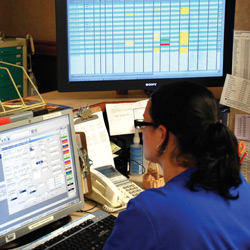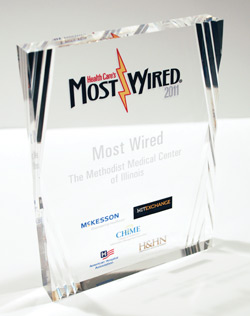
The nation's “Most Wired” hospitals and healthcare systems are transforming patient care, and Peoria’s Methodist Medical Center is one recently named as a Most Wired hospital. The 150 Most Wired hospitals are providing web-based patient education and disease-specific self-assessments online, and are linking clinical equipment to feed patient readings directly into the medical record.
"Patient care and safety are at the heart of these initiatives," says Steven Riney, Methodist vice president and chief information officer. “Methodist is among an elite group of healthcare providers nationwide who are empowering patients with information and providing tools to doctors and nurses to improve quality."
Announcement of the designation came last month. The 2011 Most Wired Survey is conducted in cooperation with Hospitals & Health Networks magazine and the American Hospital Association.
 Riney says the nation’s Most Wired hospitals are emphasizing clinical quality and patient services in their efforts to leverage technology for the benefit of their patients.
Riney says the nation’s Most Wired hospitals are emphasizing clinical quality and patient services in their efforts to leverage technology for the benefit of their patients.
Most Wired hospitals are focused on expanding and adopting certain types of information technology, such as electronic medical records (EMR). Included in the EMR “umbrella” are patients’ clinical documentation, electronic verification of medications by barcode scanning prior to giving the dose, Computerized Physician Order Entry (CPOE) and clinical results. The move to electronic systems allows physicians and other healthcare providers to have immediate access to patient history, test results and treatments, thus improving information tracking and decision making throughout each step of patient care.
The Computerized Physician Order Entry systems include electronic prescribing systems that intercept errors when they most commonly occur—at the time medications are ordered. With CPOE, physicians or other authorized health professionals enter orders directly into a computer rather than on paper. Now, instead of a patient’s medical file consisting of reams of paper, the record is stored in a secure database accessible by technology, but only to authorized medical personnel. Orders are integrated with patient information, including laboratory and prescription data. Through the electronic system, the order is reviewed for errors and additional safety risks, and the care team is alerted to investigate and resolve any problems.
Other aspects of a Most Wired designation include:
- Electronic imaging. A system of filmless x-rays and all digital imaging available via the EMR (electronic medical record).
- Portable computer workstations. Nurses, physicians and other providers with appropriate security credentials can access patient information when and where it is needed.
- Electronic medication scanning. Using a barcode scanner, nurses scan the patient’s wristband, then the medication, verifying that it is the right patient, right medication and right dose—and the right time every time.
- Internet for families and guest Wi-Fi. Providing online access for families and patients within the hospital.
Results from the Most Wired Survey show that hospitals are making progress deploying advanced IT systems designed to improve efficiency, improve quality, reduce errors and improve patient safety. iBi

